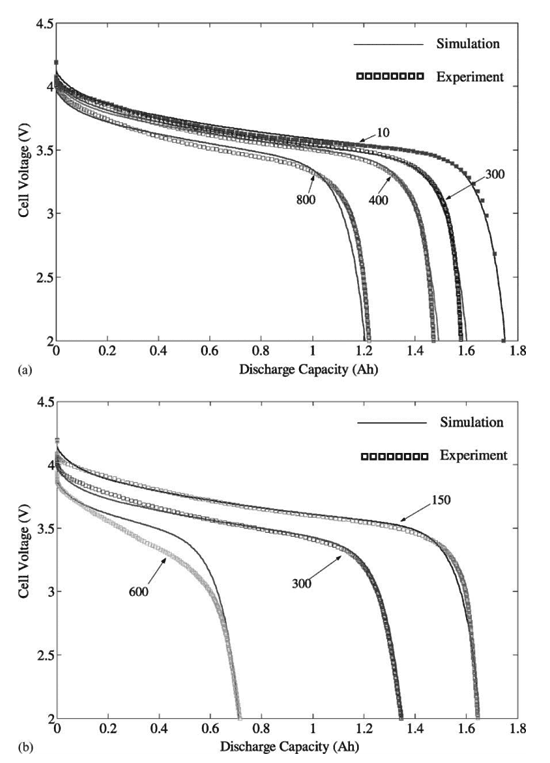I recommend doing the following to optimize battery life:
- Keep my battery as cool as possible.
- Don't worry about whether it's plugged in or not. When it doubt, keep it plugged in so it uses AC power instead of battery, unless of course it's getting hot.
It turns out that the two methods I originally posited are largely moot. The only thing that really matters is temperature.
"Temperature was the most significant factor contributing to the cell degradation, with state-of-charge (SOC) and discharge pulse length of secondary importance." (Liaw et al.)
Furthermore, it turns out that the decay can be accurately mathematically modeled:
Q = A exp(−Ea/RT) * t^z (See Ramadass et al. for explanation of terms)
However, the dominant model is that of the Arrhenius forumla, which generically predicts time-to-failure as a function of temperature.
The figure below shows the capacity at various cycle counts. Just look at the capacity on the x-axis. The top graph is at 25 C, the bottom at 50 C.
After 600 cycles, the cooler battery had ~2x the capacity
P. Ramadass et al. / Journal of Power Sources 123 (2003) 230-240

Fig. 7. Simulated discharge curves based on semi-empircal model for temperatures (a) 25 C and (b) 50 C. The dotted curves represent the experimental data obtained for Sony 18650 cells for the respective cycle numbers.
While I could still find no evidence on the behavior of Mac power circuitry, there was helpful information on the official Dell website. Two items specifically stood out.
Q. When docked or AC adapter is plugged into a wall outlet, am I using my battery charge?
A. No.
Q. Should I totally discharge, then recharge my Dell laptop battery occasionally to make it last longer?
A. No, discharging and charging does not increase the life of a Lithium Ion technology battery.
However, it is important to note that Apple and Dell charging circuits may be different. Although, given that Dell does this, I assume Apple does as well. On this assumption, unless someone can provide sources to claim otherwise, I will assume that the Apple charging circuitry is smart enough to know this.
I encourage anyone to continue exploring this question and challenge my assumptions. Please see the sources below if you're curious for a more detailed explanation.
Sources
Ramadass, P., Bala Haran, Ralph White, and Branko Popov. "Mathematical Modeling of the Capacity Fade of Li-ion Cells." Journal of Power Sources 123.2 (2003): 230-40. PDF
Liaw, B., R. Jungst, G. Nagasubramanian, H. Case, and D. Doughty. "Modeling Capacity Fade in Lithium-ion Cells." Journal of Power Sources 140.1 (2005): 157-61. PDF
Ning, G. "Capacity Fade Study of Lithium-ion Batteries Cycled at High Discharge Rates." Journal of Power Sources 117.1-2 (2003): 160-69. PDF
Ramadass, P., Bala Haran, Parthasarathy M. Gomadam, Ralph White, and Branko N. Popov. "Development of First Principles Capacity Fade Model for Li-Ion Cells." Journal of The Electrochemical Society 151.2 (2004): A196. PDF
Zhang, D., B. S. Haran, A. Durairajan, R. W. White, Y. Podrazhansky, and B. N. Popov. "Studies on Capacity Fade of Lithium-ion Batteries." Journal of Power Sources 91 (2000): 122-29. PDF
Note: This comes from my recent answer on Ask Different.

If you have a Lenovo laptop, it probably supports a feature called conservation mode. This mode is designed to extend the service life of the battery by limiting the maximum charge level to 55-60%. On newer models, you can enable it through the Lenovo Settings app. – bwDraco – 2017-06-14T18:38:15.360
1
Good info here...http://h10025.www1.hp.com/ewfrf/wc/document?lc=en&dlc=en&cc=us&lang=en&product=4125509&docname=c00596784
– Moab – 2010-10-10T23:11:30.3431
Related question: Is it better to use a laptop on battery or on AC power? http://superuser.com/questions/12358/is-it-better-to-use-a-laptop-on-battery-or-on-ac-power
– sleske – 2011-05-12T10:24:40.933